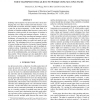Free Online Productivity Tools
i2Speak
i2Symbol
i2OCR
iTex2Img
iWeb2Print
iWeb2Shot
i2Type
iPdf2Split
iPdf2Merge
i2Bopomofo
i2Arabic
i2Style
i2Image
i2PDF
iLatex2Rtf
Sci2ools
ISCAS
2002
IEEE
2002
IEEE
Video transport over ad-hoc networks using multiple paths
Enabling video transport over ad-hoc networks is more challenging than over other wireless networks because a connection path in an ad-hoc network is highly error-prone and a path can go down frequently. On the other hand, it is possible to establish multiple paths between a source and a destination, which provides an extra degree of freedom in designing video coding and transport schemes. In this paper, we review several video encoding and transport control techniques, all assuming that a routing protocol is able to set up and constantly update two paths each made of multiple links. The techniques that we have examined include i) layered coding and selective Automatic Repeat Request (ARQ), ii) reference picture selection, and iii) multiple description coding. Depending on the availability of a feedback channel, the delay constraint, and the error characteristics of the established paths, one technique is better suited than another. These techniques are also applicable to other networ...
| Added | 15 Jul 2010 |
| Updated | 15 Jul 2010 |
| Type | Conference |
| Year | 2002 |
| Where | ISCAS |
| Authors | Shunan Lin, Yao Wang, Shiwen Mao, Shivendra S. Panwar |
Comments (0)

